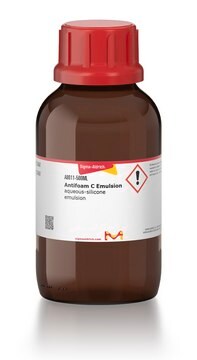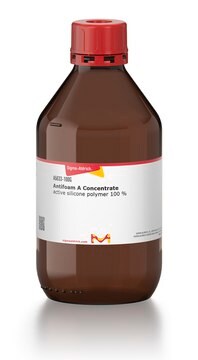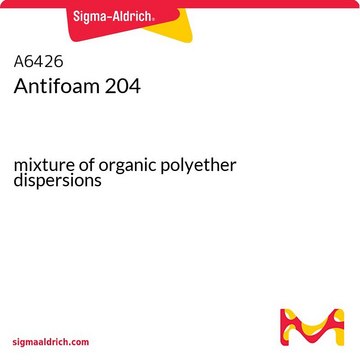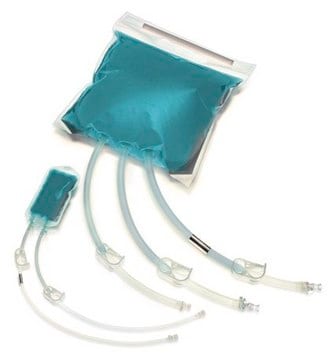Key Documents
A6582
Antifoam A concentrate
active silicone polymer 100%
Synonim(y):
Antifoam agent, Antifoam solution, Foam control agent
About This Item
Polecane produkty
Poziom jakości
Postać
emulsion (aqueous)
metody
cell culture | hybridoma: suitable
microbiological culture: suitable
gęstość
0.97 g/mL at 25 °C
Zastosowanie
microbiology
temp. przechowywania
room temp
przydatność
(Mammalian (suspension))
bacteria (fermentation)
Opis ogólny
Zastosowanie
- in bioreactor culture for Staphylococcal enterotoxin C (SEC) production.
- to prevent foam formation during the aerobic treatment of sludge.
- to study the impact of surface tension on bioaerosol generation during bubbling.
Cechy i korzyści
- Molecular biology grade and tested for use in bacterial fermentation.
- Extremely effective foam suppressor for aqueous and non-aqueous systems.
- Made of 100% active silicone polymer, free of emulsifiers.
- Typically, effective at 1-100 ppm.
- Product will be stable in the pH range of 5 to 9.
- Can be directly added to a fermentation medium but it is not recommended that it be pumped to a fermenter on an as-needed basis.
Komponenty
Uwaga dotycząca przygotowania
produkt powiązany
Hasło ostrzegawcze
Warning
Zwroty wskazujące rodzaj zagrożenia
Zwroty wskazujące środki ostrożności
Klasyfikacja zagrożeń
Aquatic Acute 1 - Aquatic Chronic 1
Kod klasy składowania
10 - Combustible liquids
Klasa zagrożenia wodnego (WGK)
WGK 3
Temperatura zapłonu (°F)
>213.8 °F - closed cup
Temperatura zapłonu (°C)
> 101 °C - closed cup
Środki ochrony indywidualnej
Eyeshields, Gloves, type ABEK (EN14387) respirator filter
Certyfikaty analizy (CoA)
Poszukaj Certyfikaty analizy (CoA), wpisując numer partii/serii produktów. Numery serii i partii można znaleźć na etykiecie produktu po słowach „seria” lub „partia”.
Masz już ten produkt?
Dokumenty związane z niedawno zakupionymi produktami zostały zamieszczone w Bibliotece dokumentów.
Nasz zespół naukowców ma doświadczenie we wszystkich obszarach badań, w tym w naukach przyrodniczych, materiałoznawstwie, syntezie chemicznej, chromatografii, analityce i wielu innych dziedzinach.
Skontaktuj się z zespołem ds. pomocy technicznej








